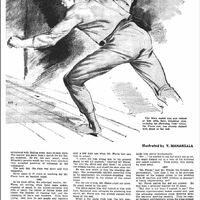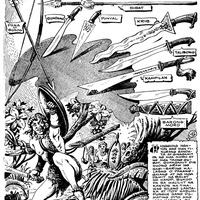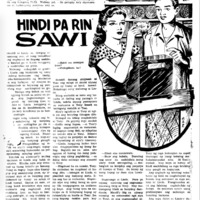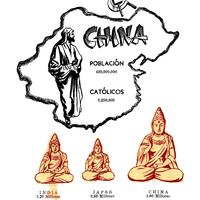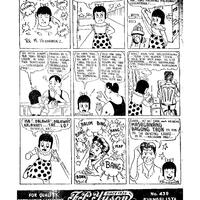The independence of the Philippines from the US on July 4, 1946, marked a new era in the press, with the proliferation of periodicals in Filipino and other regional languages. In this context, two elements are relevant to the production of periodicals and the representation of
minorities. The first was decolonization, or the undoing of the formal linkages that tied the former colonial power to the economic and political control over the colony. Decolonization would often become a galvanizing agent both in international cooperation (such as the Bandung conference) and in the discourse on ideologies, which became significant during the Cold War.
The second element were the efforts at regionalization, which increased dramatically. Regional organizations, such as the Association for Southeast Asian Nations, the Organization of African
Unity, or the Arab League, among others, would emerge in the two decades following the end of WWII. While regionalization in Southeast Asia strove to meet economic and development
objectives in light of newfound independence and the end of WWII, ensuring non-interference was intended to consolidate control over territorially-bound states and their respective inhabitants (Ramcharan 2000, p. 65). Thus, the end of the colonial period brought a reckoning
with the ethnic, economic, religious, and linguistic divides within nation-states enclosed within colonially-drawn borders.
The desire to consolidate territory and national identity was reflected in nationalist
historiography, which, in the Philippines, involved subsuming the identity of the Moros in a common resistance against foreign occupiers (Majul 1966). There are several critiques of this view –such as the view that Muslim polities, unlike the ilustrados’, did not launch collective resistance against the occupiers in defense of a larger polity or anti-colonial fervor (Abinales 2010, 39-40). All the same, the discourse around Moro identities in popular media run largely from Manila was built upon colonial foundations: it circled around narratives of distinctiveness yet animosity, belongingness yet strangeness. These narratives were circulated in official languages that were only largely accessible to the educated public, and their scope of geographic distribution remains yet unclear.
The depictions of ‘Moros’ and ‘Muslims’ in the Philippines were seen in both literary and non-
literary periodicals. It is important to note that these journals do not encompass the time period of the creation of groups such as the Moro National Liberation Front (MNLF), the Moro Islamic Liberation Front (MILF), or the related political collectives that advocated for an independent Bangsamoro territory. In that sense, these periodicals reflect publishing houses and views from
the Christian-dominated population. Prior to this period, however, old prejudices and views would be reflected across periodicals and the languages used in the Philippines. During the American period, Moros were largely associated with violence and a traditional lifestyle. Both English-language and Filipino periodicals depicted Moros either in acts of violence, or in association with weapons.
An illustration depicting a Moro wielding a Kris.
An illustration depicting different traditional weapons used in the Philippines.
Naturalization became a possibility for Chinese in the Philippines in 1840 (Chu 2002, 358) and, in the 20 th century, through the Letter of Instruction no. 270, s. 1975, granting the “Naturalization of deserving aliens by decree”. This signified a political change away from monocultural conceptions of the nation towards a political form of nationalism that allowed for cultural plurality (Cariño 1988, 47, cited in Hau 2005, 497). Hence, the Chinese population in the contemporary Philippines is often described as having three possible categories: those who identify as Chinese Filipinos, those who identify with the People’s Republic of China, and those who identify with the Republic of China (Hau 2018). However, in print media discourses of the two decades after WWII, little distinction was made between Chinese with long-established roots in the Philippines and recent arrivals –the word intsik/insic became a term for any Chinese in the Philippines, albeit with derogatory connotations. The term was equally applied to refer to Chinese from the mainland, as with the word ‘Chino’. Associations between the Chinese and trade, and Chinese and entrepreneurship, continued throughout this period.
As with the American and Spanish colonial periods, economic rivalry continued to underpin and accompany the otherwise racialized and racist portrayals of the Chinese.
An illustration depicting a Chinese man behind the counter at a store.
Furthermore, the discourse of suspicion, resentment and othering would persist well after independence: while nationalist rhetoric would often include assimilatory statements, the difficulties in distinguishing between longtime settlers and transient settlers would fuel the lack of nuance in dealing with the Chinese. Nationalism on an economic dimension would express
itself in anti-foreign sentiment, as can be seen in a letter bemoaning the dominance of the ‘Chinese’ in businesses, indicating that they were not seen as entirely belonging to the local
population of the country.
A letter lamenting patronizing Chinese stores
If economic rivalry was seen as a continuing feature in the discourse on the Chinese in the Philippines, religious conversion was another. In 1840, one of the prerequisites of becoming
naturalized as a Spanish subject for Chinese in the Philippines was to be baptized into the Catholic Church. Seeing as there was little distinction made between the Chinese in the
Philippines and those in China in the two decades following WW2, this begs the question as to how the Chinese in the Philippines who had not converted to Catholicism would be regarded by religious orders: ‘Chinese’ functioned as targets for conversion in the 1950s. Even if the periodical was largely centered on the Chinese in China, other representations implied that the Catholic discourse in the Philippines still advocated conversion of the Chinese.
Socially, there was recognition that the Chinese had become a prominent feature in society, with depictions as shopkeepers or businessowners abounding. Even so, structural barriers that
would prevent their acceptance as a minority existed alongside cultural prejudices.
The Chinese as targets of conversion in China
A comic on a Chinese family.
A comic mocking how Chinese in the Philippines spoke Filipino
We have seen how the independence period, with a growing number of periodicals, including those in Filipino, would attain more visual components. Seen in terms of discourse, the connotations of identities that had existed since colonial periods continued to appear in the newspapers, with few counter-discourses or self-representations.

